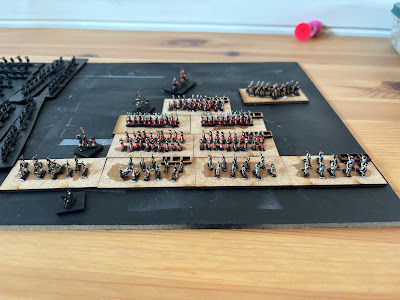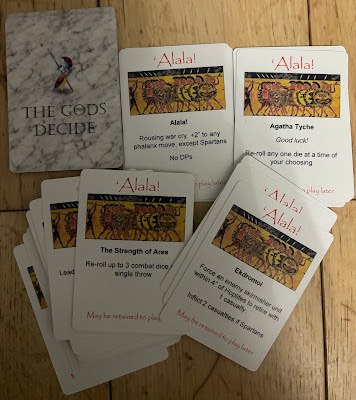The rival armies have been mobilised and ready for over 2 weeks, but each hesitated to be the first to strike the first blow. Each wanted to avoid being the first to initiate bloodshed with fellow Christians. Catholics all (apart from the English that is, and Swiss auxiliaries). Obviously the real reason was a mixture of 'Real Life" and lethargy. The lethargy was overcome today and I snatched a couple of hours after work.
1741
I started the campaign in Spring 1741. Whilst the Spanish and French were stuck on the western side of the Alps by deep snow in the passes, Austrian forces headed south from Milan and crossed the Po, heading for Piacenza. The plan was to occupy an advanced position until the siege train could arrive with reinforcements from Austria.
Meanwhile the Neapolitans struck out from Naples and Bari, either side of the Apennines. Their advance north was temporarily halted when they came up against high spurs from the mountains. The snows were melting but freezing temperatures at night made the going impossible as the melted snow turned to ice. The alternative was to cut through Papal lands, at the risk of alienating His Holiness, but by June the way was clear for the Neapolitans to continue north.
July saw the Alpine passes clear and Spanish from the west (Toulon), French from the north west (Grenoble) and Austrians from the north east began to cross to northern Italy. The second Austrian army ("Aust2") brought with it a siege train which would help them capture the cities of the great north Italian plain. In this game only the French, Austrians and British had siege trains of their own - the British have no land troops so they rely on their Piedmontese or Austrian allies; just as the Neapolitans and Spanish rely on the French siege train. A restriction on the British is that their guns cannot be taken further inland than the coastal strip. Hearing reports of the French advancing east towards Lombardy, the first Austrian army ("Aust1") recrosses the Po into the northern plain to protect Milan. The Piedmontese concentrate 2/3 of the army on Cuneo, with the balance remaining in Turin.
In August Aust2 advance toward Verona, whilst Aust1 headed back to Milan to forestall the French arriving from the west. On the Mediterranean coast Spanish and Piedmontese armies arrived outside Nice where a battle is fought. Both sides had 2 bases (stacking limits in mountains prevented all the Spanish arriving together. The King of Sardinia won inflicting 3 hits on the Spanish to 1. The Spanish have to retreat back along the coast to the nearest friendly city, i.e. Toulon.
September saw the Piedmontese move from Turin to Cuneo (opening up the option to attack Toulon or Genoa. Aust2 arrived at Verona which they placed under siege. For the Bourbons, the main Neapolitan force crossed to east side of the Apennines. The Spanish reinforced the defeated army west of Nice from Toulon (i.e. the losses are transferred to the force in Toulon). Having fully crossed the Alps the French concentrate west of Milan, neither side strong enough to risk battle against the other.
The following month was fairly quiet as the Austrians and French stood off in Lombardy, and the Spanish and Piedmontese eyed each other warily between Toulon and Nice. The siege of Verona progressed steadily without conclusion.
The campaigning season trailed off in November with the Piedmontese reinforcing Nice and the Veronese finally capitulating. Britain had yet to make a show - a clear opportunity for a landing had not yet arisen. With the arrival of Winter all armies have to go back to a friendly city. All are well provided for, except the Neapolitans who are faced with crossing the Ligurian Alps to Genoa, suffering attrition en route. I rationalised that the RN blockading Genoa limited supplies for the additional 30,000 mouths.
 |
| The position at the end of 1741. In this shot I'd omitted to move 2 Spanish bases back to Toulon. |
The French are back across the Alps. In Genoa with the Neapolitans is the small Genoese army. It isn't allowed to move out of the city hex until the city is attacked, then it is a full combatant on the Bourbon side.
1742
Only the Piedmontese were allowed to replenish their losses because they still held their 3 native cities (Turin, Cuneo and Nice). In game terms the Savoyard districts of Piedmont are not counted.
Half of Aust2 with the siege train made its way to invest Padua. The rest, now all 'Aust1' unite just north of the Po making for Parma. All the Gallispans (French and Spanish) are beyond the mountains and have to wait for the passes to clear. In May Aust1 arrived at Parma but has to await the siege train, currently engaged at Padua, before it can take the city.
The next month (June) the Neapolitans cross the mountains from Genoa to Piacenza. Aust1 attacks them but are repulsed with a difference of 1 so both take a hit. The Austrians have to retreat. The siege of Padua continues.
In July the French start to cross the Alps. This time their plan is different. They threaten Turin. The Piedmontese troops in Turin remain in place waiting to see what happens. The Neapolitans also remain in place keeping their option open. Aust1 recrosses the Po and Padua falls to Aust2. The other 2 Piedmontese bases move east of Nice threatening Genoa, hoping to link up with the Royal Navy.
A double 5 is rolled on 2D6 which mean an 'Event' Occurs. A 6 rolled on D8 means that Charles of Lorraine (brother-in-law of the Austrian Empress*) marches to Rhine, and the French must remove a base from Italy for 18 months.
In the heat of August, Aust1 sends 1 base to Milan. Aust2 advances up the northbank of the Po. Then the French (2 bases plus a siege train) move on Turin, accompanied by 2 Neapolitan bases! At the same time the Spanish start to cross Alps threatening Piedmont from the west.
Through September the French and Neapolitans invest and besiege Turin, which is defended by 1 base of Piedmontese. Meanwhile the other 2/3 of the Piedmontese army meets 2/3 of the Spanish outside Cuneo and fight the (first?) Battle of Madonna dell Olmo! Piedmont gets an extra dice because of the friendly city. The adjusted dice rolls result in 5 against the Spanish. A disaster for Spain who take 5 hits (a base) against one for the victors. All the Austrians advance up the Po valley towards Piedmont to help their allies.
In October Aust1 joins up with the Piedmontese east of Turin, whilst Aust2 remains South of Milan. The Franco-Neapolitans have 3 options:
- press on with the siege of Turin,
- retreat through the Alps, or
- attack Austro-Piedmontese
Stuck for a decision I let the Dice Gods decide. A 2 on a D6 means they press on with the siege, hoping to take it before the Austro-Piedmontese army attacks them. Unfortunately for the Bourbons, Turin does not immediately fall.
November: Another double is rolled. This time a 4 on a D8 means a Storm. This forces fleets close to the shore, but not in a friendly harbour, out to sea, breaking any blockade. The British are forced away from Genoa.
But things get worse for the Bourbons. The whole Piedmontese army converges with Aust1 (3 bases) by Turin to offer battle. The numbers to start with are as follows:
Piedmont: 3 bases = 15 points less 1 hit already = 14
Austria: 3 bases = 15 points less 1 hit already = 14
Total Austro-Piedmontese = 28 plus 2D6 (1 plus 1 extra for the friendly city)
French: 2 bases = 10 points
Neapolitans: 3 bases = 10 points
Total Bourbons = 20 points plus 1D6
With such unfavourable odds the combined Bourbon army elects to retreat NW of the Po to the Alps. They cross to the French side for the Winter.
1742 comes to an close with the Bourbons at a definite disadvantage. The Austrians have gained 2 cities, and are pretty much unchallenged in the plains. But at least for the next campaign, the French, Spanish and Neapolitans all start the year circling Piedmont from 3 directions. The bad news is, they have to wait for the thaw before they can cross. They need some good fortune!
This campaign could end fairly quickly if I'm not careful. I'm considering allowing reinforcements to Toulon and Genoa as a result of the storm that forced the RN to lift the blockade. Additionally I think a stacking limit during winter should force armies to disperse more (this will work a little against the Austro-Piedmontese). I'm also considering allowing armies without a siege train to take cities by assault - at the risk of losing points - 1 hit for a successful storm and 2 or 3 for unsuccessful. Thoughts?


















































